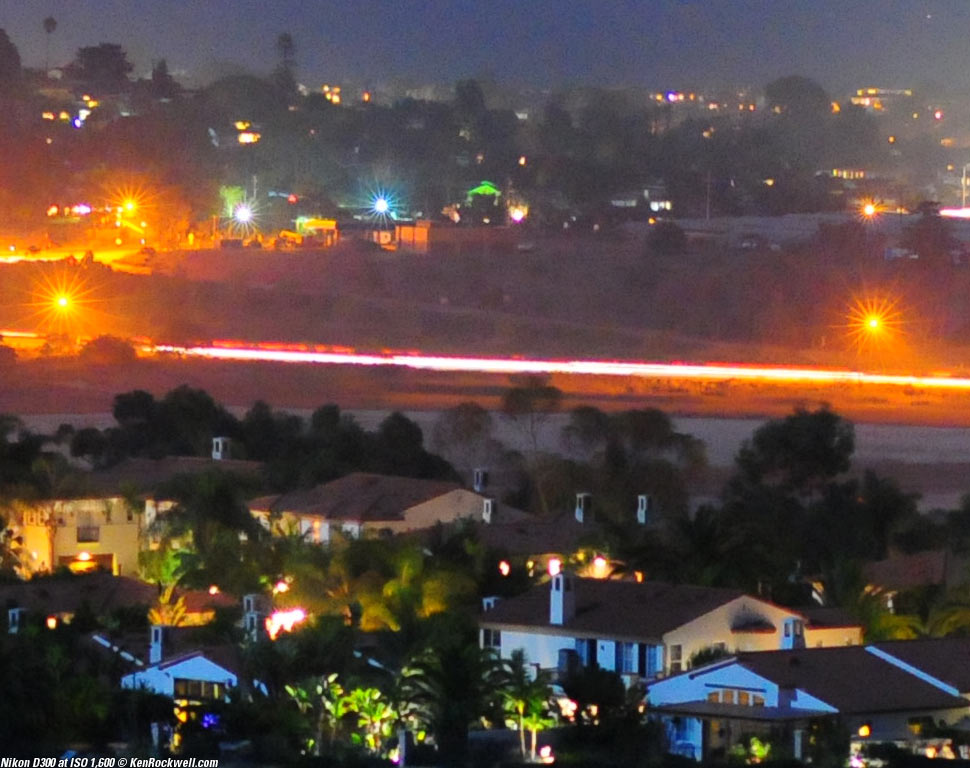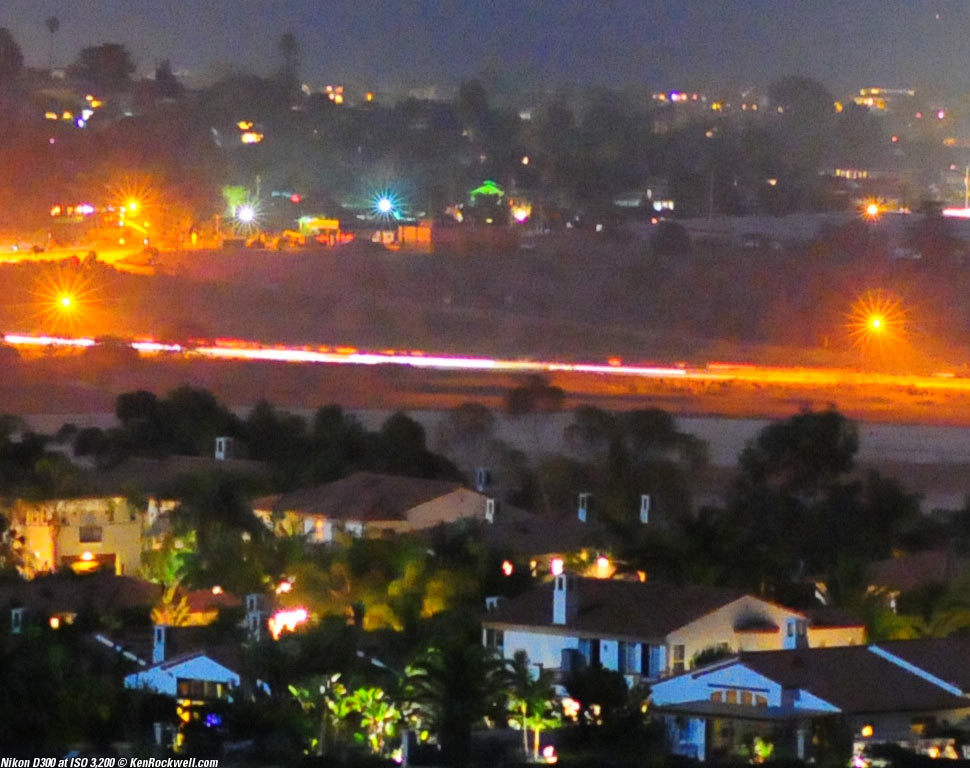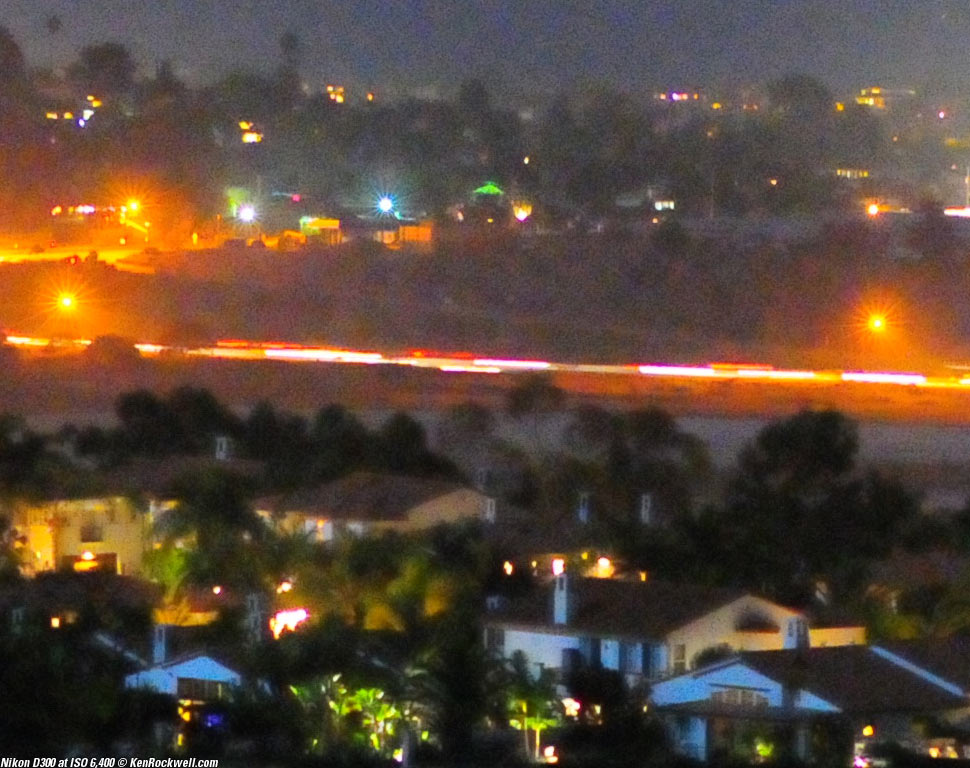Moonlight High ISO Comparison: Nikon D300 vs. D200
© 2007 KenRockwell.com
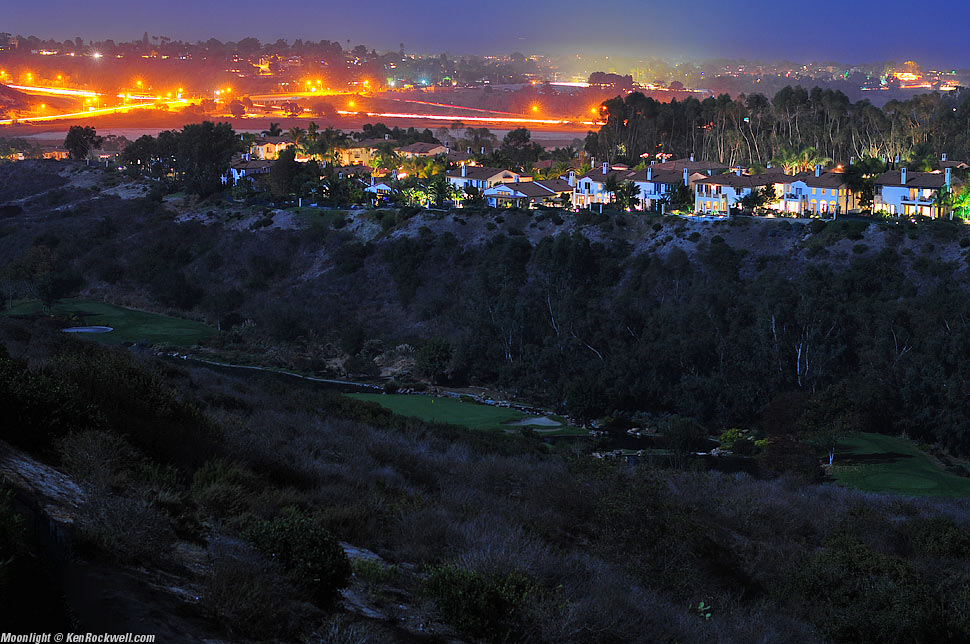
Moonlight. (also the full image from which the crops are taken.)
I get my
goodies at Ritz, Amazon, Adorama.
It helps me
keep adding to this site when you get yours from those
links, too.
See also Nikon D300, D200, D40 and Canon 5D High ISO Comparison, Canon 40D, 5D, Rebel XTi and Nikon D40 and D200 High ISO Comparison and 2006's comparison.
November 2007
WARNING: High ISOs are not authorized for use on tripods. I received special permission to run these tests. One always should use the lowest ISO, even at night, on a tripod. High ISOs are for hand-held use, or for use by slackers who don't want to wait for long time exposures. The best results for night shots always come from the lowest ISO setting or film.
These shots were made the very first night anyone had a Nikon D300. It was also the full moon (23 November 2007), so away I went to a golf course near Rancho Bernardo, California and had at it.
This compares both cameras on the same grounds: same shot, same tripod, same exposure, same lens and same final print size (tech details below). All of these would print at 43" (1.1m) wide if you printed the entire image at the magnifications shown below. I rarely print this big; do you?
For most normal use, any of these images look fine, and only a clown would be shooting at ISO 400 on a tripod anyway.
Use the "skip to ISO" links to switch instantly among the various ISOs and you'll see how they vary.
Skip ahead to Analysis
Skip ahead to Conclusion
ISO 100 back to top Mouse Over to compare.
skip to ISO 100 ISO 200 ISO 400 ISO 800 ISO 1,600 ISO 3,200 ISO 6,400
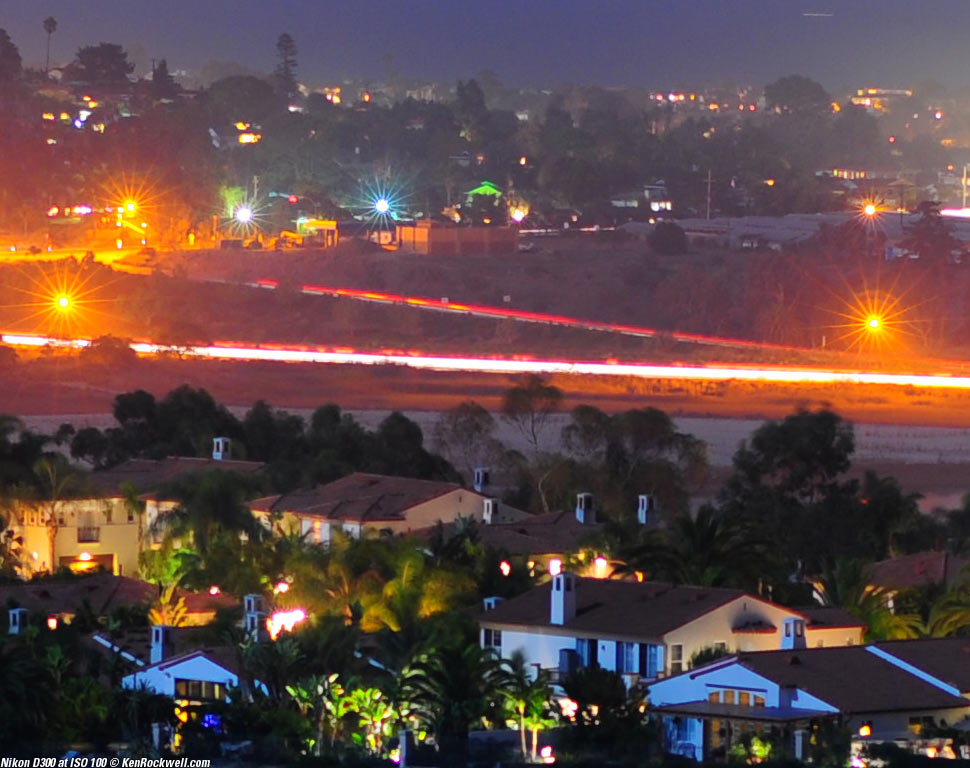
ISO 200 back to top Mouse Over to compare.
skip to ISO 100 ISO 200 ISO 400 ISO 800 ISO 1,600 ISO 3,200 ISO 6,400
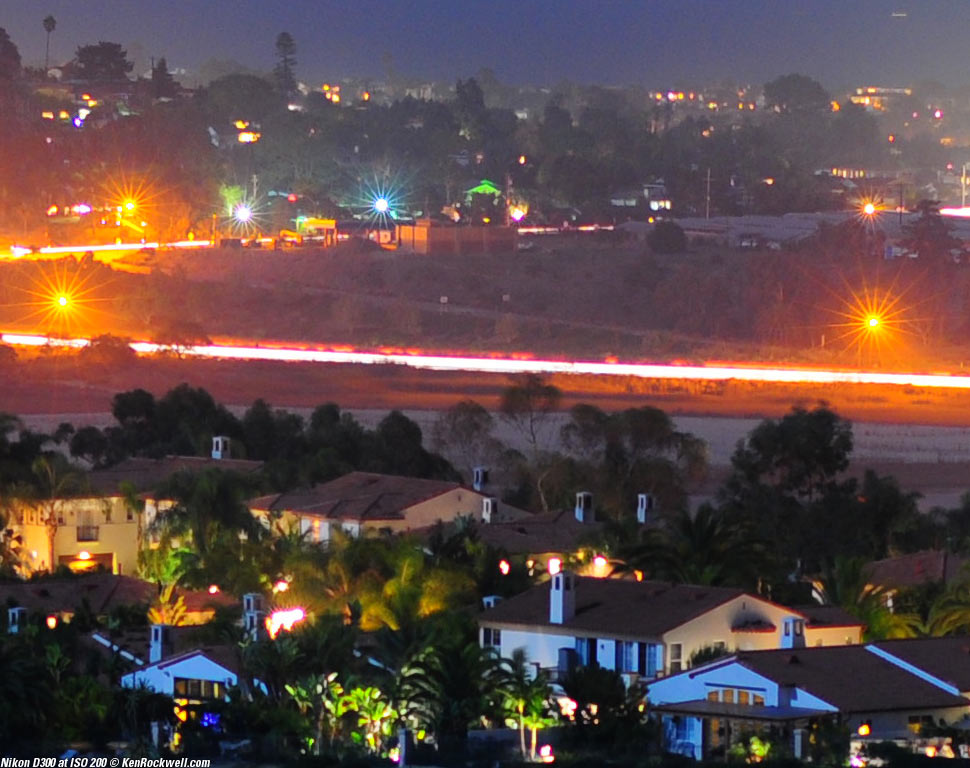
ISO 400 back to top Mouse Over to compare.
skip to ISO 100 ISO 200 ISO 400 ISO 800 ISO 1,600 ISO 3,200 ISO 6,400
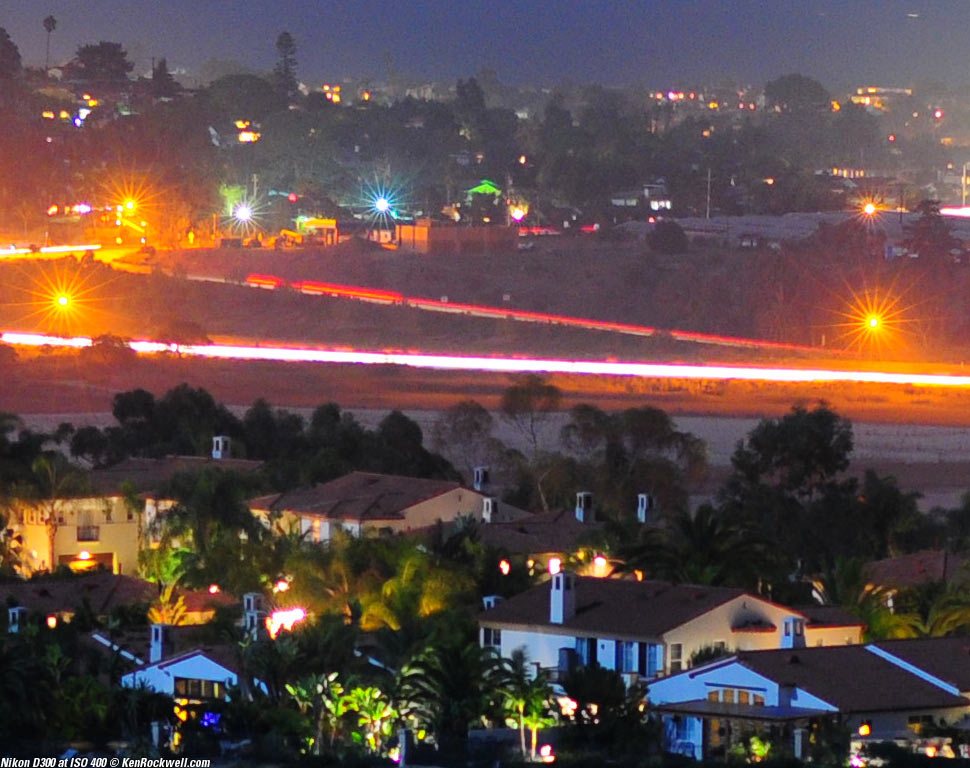
ISO 800 back to top Mouse Over to compare.
skip to ISO 100 ISO 200 ISO 400 ISO 800 ISO 1,600 ISO 3,200 ISO 6,400
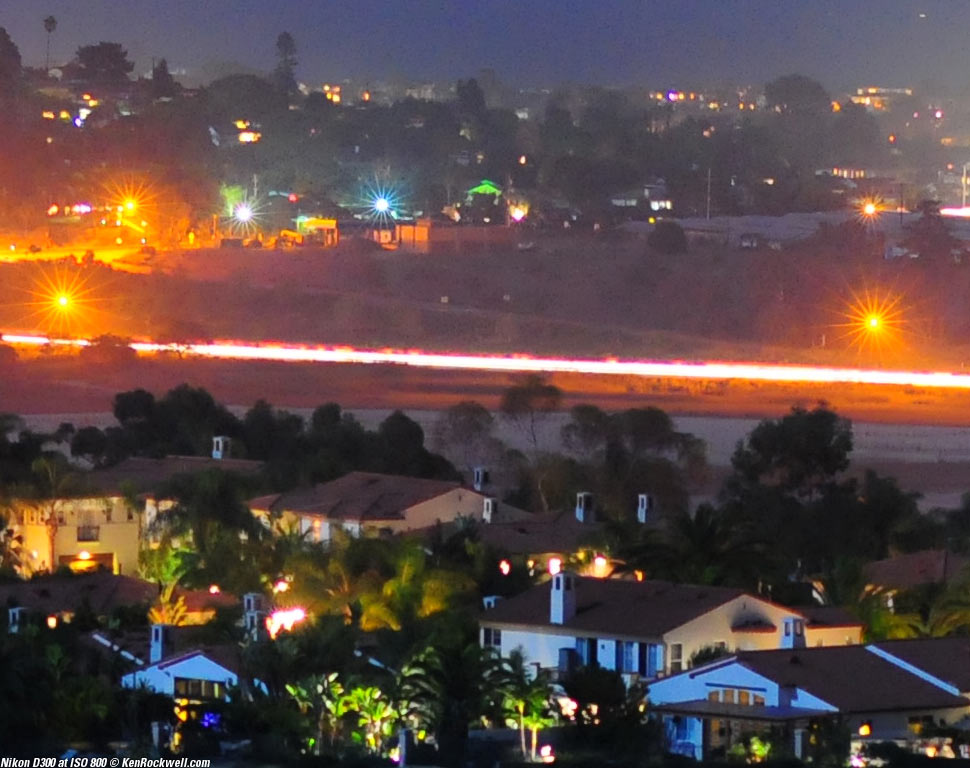
ISO 1,600 back to top Mouse Over to compare.
skip to ISO 100 ISO 200 ISO 400 ISO 800 ISO 1,600 ISO 3,200 ISO 6,400
ISO 3,200 back to top Mouse Over to compare.
skip to ISO 100 ISO 200 ISO 400 ISO 800 ISO 1,600 ISO 3,200 ISO 6,400
Note: The D200 crushes the blacks to hide noise, making it darker than the D300. I therefore lightened the D200 image to match the D300 for a closer comparison.
ISO 6,400 back to top Mouse Over to compare. The dark trees are blurred away by the D300's noise reduction!
skip to ISO 100 ISO 200 ISO 400 ISO 800 ISO 1,600 ISO 3,200 ISO 6,400
(I pushed the D200 to ISO 6,400 in Photoshop)
Analysis back to top
The D300 looks far better at reasonable ISOs. It's sharper and far more vivid. The D300 is more vivid because these are the very first shots I made with my D300, and I had not realized that the D300 has far more potent colors when cranking the saturation. The D300 here, which I set to VIVID and +3 saturation as soon as I took it out of the box, is wild and alive, while the D200, set to Color Mode III and + Saturation, is relatively dead. Next time I'll set the cameras more similarly.
The D200 looks poor here also because it shot with a much lower contrast. The D200 has much better shadow detail in most of the image, but since I'm only showing crops, you're not seeing it here. Look in the dark trees, and you'll see far more detail in the D200. If your eyes look at the stars in the bright lights, of course the D300 looks far better. The D200's noise reduction is painting over some fine details even at reasonable ISOs, while the D300 leaves them alone.
Technical back to top
I used a brand new Nikon 50mm f/1.2 AI-s lens at f/2.8. Its 9-bladed diaphragm is what makes the exquisite 18-pointed stars on the brilliant highlights. Manual focus lenses are ideal for night landscapes because they have hard infinity stops for focusing. This way you can set them to the stop and know, presuming you've checked the calibration, that you have perfect focus even in pitch black.
Exposure times for both cameras was:
ISO |
Manual Shutter Speed |
100 |
32s |
200 |
16s |
400 |
8s |
800 |
4s |
1,600 |
2s |
3,200 |
1s |
6,400 |
1/2s |
I didn't use the D300's excellent (but not default) Adaptive Dynamic Range.
I slightly upsampled the D200 images to match the size of the D300 images.
High-ISO (spatial) noise reduction was left at its default of NORM on both cameras.
Long Exposure (dark-frame subtraction) NR was also left at its default of off on both cameras. As I showed back in 2005, even the D200 has no problems with pink corners with long exposures. Long Exposure NR isn't needed with modern cameras unless you're crazy.
Conclusion back to top
Of course the D300 looks better most of the time, not because of noise, but because 1.) it can crank its colors further. 2.) is has Adaptive Dynamic Range which uses Ansel Adams' Zone System to avoid blowing out highlights, and 3.) magically corrects lateral color in lenses to make them sharper than they are on other cameras.
Noise-wise, the D300 looks better at reasonable ISOs, but gets too heavy with its NR at high ISOs and makes the image look as if a fog had rolled in.
Moonlight tests are a weird example. No one should use high ISOs on a tripod; one should use ISO 100 and long exposures. A far more meaningful (but less pretty) live-jungle comparison is my Nikon D300, D200, D40 and Canon 5D High ISO Comparison.
In actual use, the D300 can't use ISO 100 when in Auto ISO as I always shoot my cameras. (Auto ISO does nothing, unless the light gets too dim for a sharp shot, in which case only then will it start increasing the ISO.) Sadly, the D300 defaults to ISO 200 most of the time, and all of the time in Auto ISO, so in actual daily use, my D200 is cleaner because my D200 defaults to ISO 100!
Forget about noise. There are far more visibly different issues among cameras, like contrast and color adjustments, which are vastly more different and important. There is more difference from one ISO setting to the next than there is between any of these cameras, which is why the D200 is cleaner in daily use at ISO 100 than the D300 at ISO 200.
I'd go with the D300, which clearly wins on color and tone.
PLUG
If you find this as helpful as a book you might have had to buy or a workshop you may have had to take, feel free to help me continue helping everyone.
Thanks for reading!
Ken

